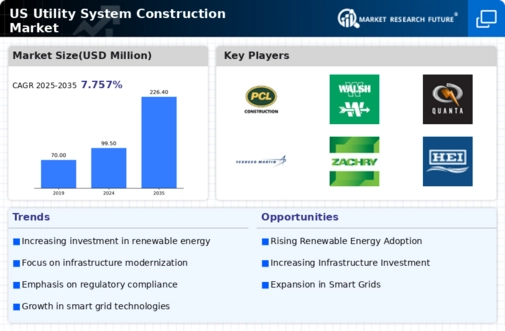Infrastructure Investment Growth
The utility system-construction market is currently experiencing a surge in infrastructure investment, driven by both federal and state initiatives aimed at modernizing aging utility systems. The Biden administration's infrastructure plan allocates approximately $1.2 trillion for various projects, including water and energy systems. This influx of funding is expected to enhance the resilience and efficiency of utility networks, thereby stimulating demand for construction services. As municipalities and utility companies seek to upgrade their facilities, the market is likely to see a significant increase in construction contracts. Furthermore, the emphasis on improving infrastructure is anticipated to create job opportunities, contributing to economic growth. This trend indicates a robust future for the utility system-construction market, as stakeholders prioritize investments in sustainable and reliable utility systems.
Population Growth and Urbanization
The utility system-construction market is significantly impacted by ongoing population growth and urbanization trends across the U.S. As urban areas expand, the demand for reliable utility services, including water, electricity, and telecommunications, intensifies. The U.S. Census Bureau projects that the population will reach approximately 400 million by 2050, necessitating substantial investments in utility infrastructure to accommodate this growth. Urbanization leads to increased pressure on existing systems, prompting municipalities to undertake extensive construction projects to enhance capacity and reliability. This trend is likely to drive sustained demand for construction services within the utility sector, as stakeholders prioritize the development of resilient infrastructure to support growing populations and urban environments.
Rising Demand for Renewable Energy
The utility system-construction market is witnessing a notable shift towards renewable energy sources, driven by both consumer demand and government policies. As the U.S. aims to reduce greenhouse gas emissions, there is a growing emphasis on constructing infrastructure that supports solar, wind, and other renewable energy projects. According to the U.S. Energy Information Administration, renewable energy is projected to account for over 50% of electricity generation by 2030. This transition necessitates significant investment in new utility systems, including grid upgrades and energy storage solutions. Consequently, construction firms specializing in renewable energy infrastructure are likely to see increased opportunities. The push for cleaner energy not only aligns with sustainability goals but also positions the utility system-construction market for substantial growth in the coming years.
Regulatory Compliance and Standards
The utility system-construction market is heavily influenced by evolving regulatory frameworks and compliance standards. Federal and state regulations are increasingly stringent, particularly concerning environmental protection and safety protocols. For instance, the Environmental Protection Agency (EPA) has implemented new guidelines that require utility companies to upgrade their systems to meet higher environmental standards. This regulatory landscape compels construction firms to adapt their practices, often leading to increased project costs. However, compliance also drives innovation, as companies invest in advanced technologies and sustainable materials to meet these standards. The necessity for adherence to regulations is likely to sustain demand for construction services within the utility sector, as firms strive to align with legal requirements while enhancing operational efficiency.
Technological Advancements in Construction
The utility system-construction market is being transformed by rapid technological advancements that enhance construction efficiency and project management. Innovations such as Building Information Modeling (BIM), drones, and advanced materials are streamlining processes and reducing costs. For instance, the use of drones for site surveys can significantly decrease the time required for project planning and execution. Additionally, smart technologies are being integrated into utility systems, allowing for real-time monitoring and maintenance. These advancements not only improve the quality of construction but also enable firms to deliver projects more quickly and within budget. As technology continues to evolve, the utility system-construction market is likely to benefit from increased productivity and reduced operational risks, fostering a competitive edge for early adopters.




















Leave a Comment